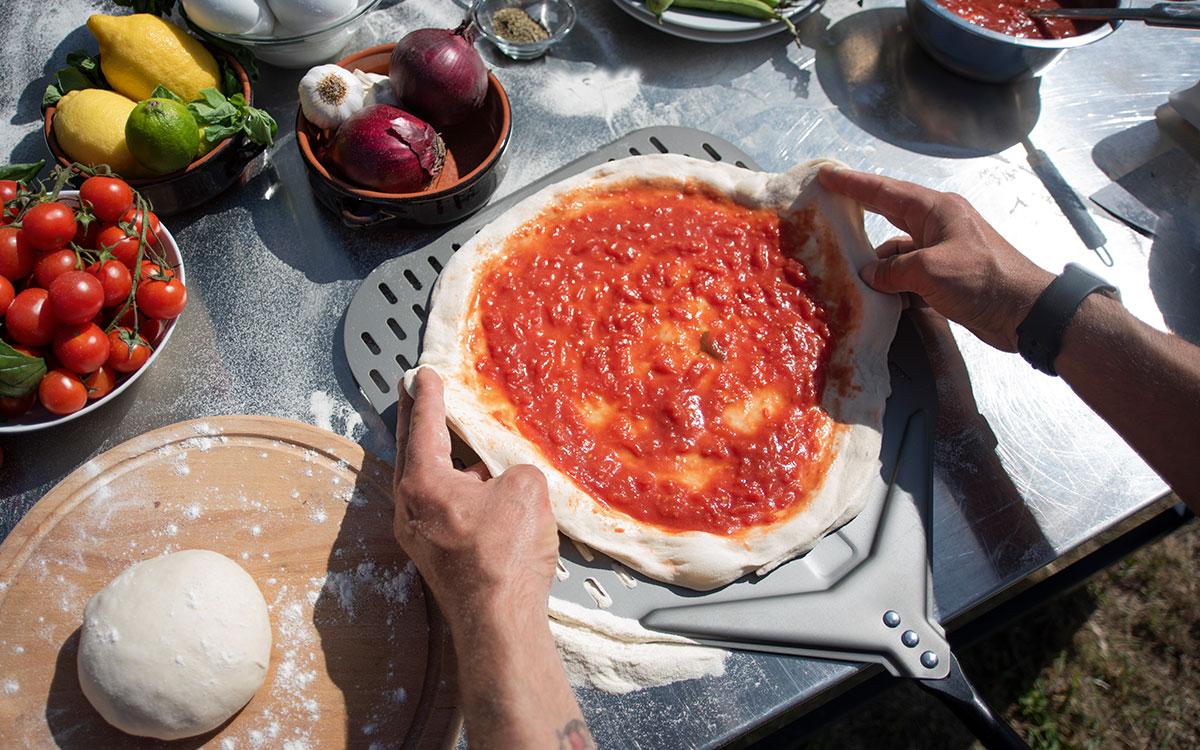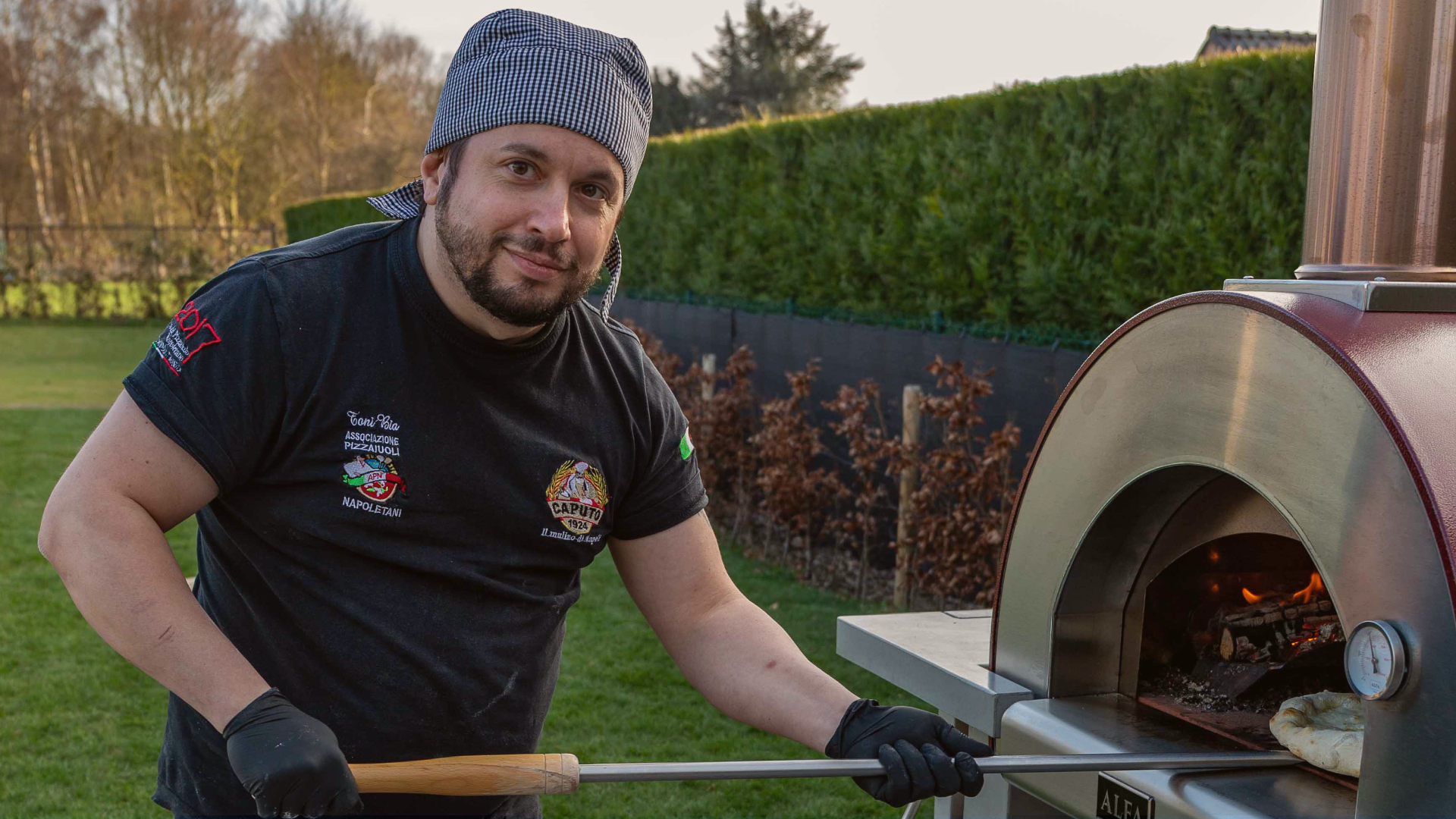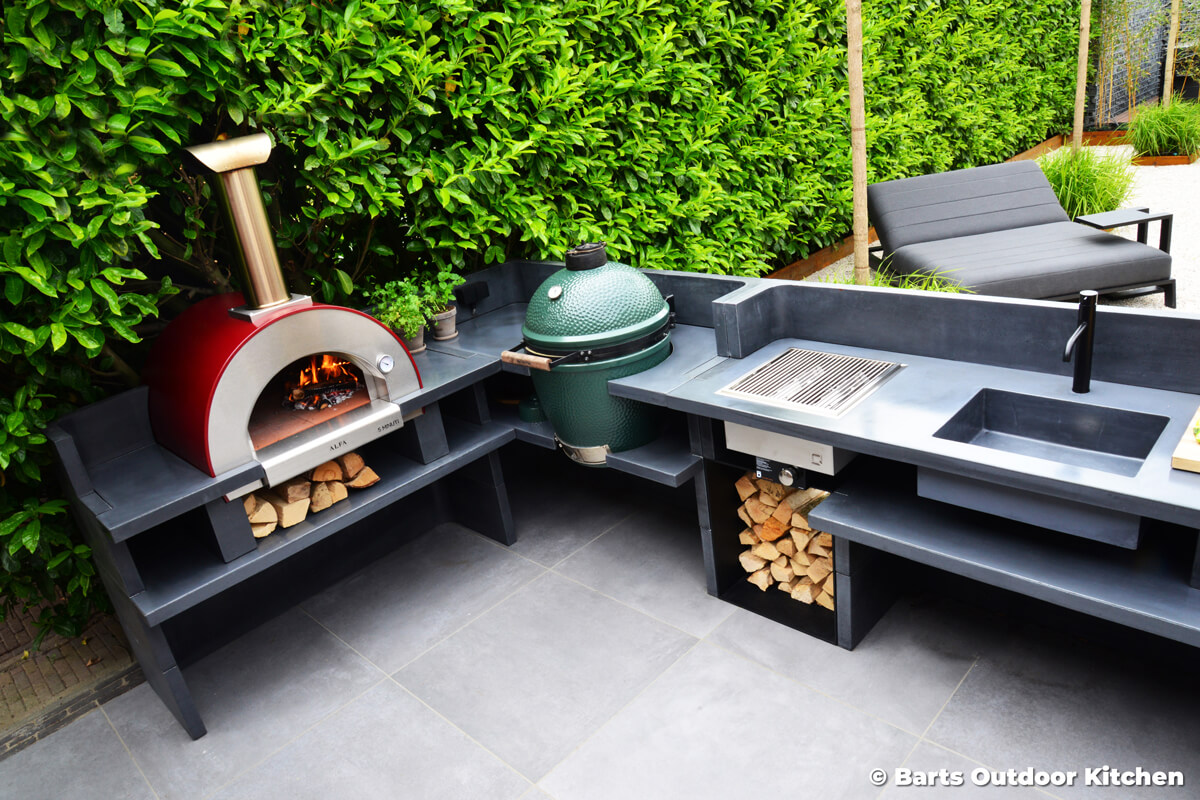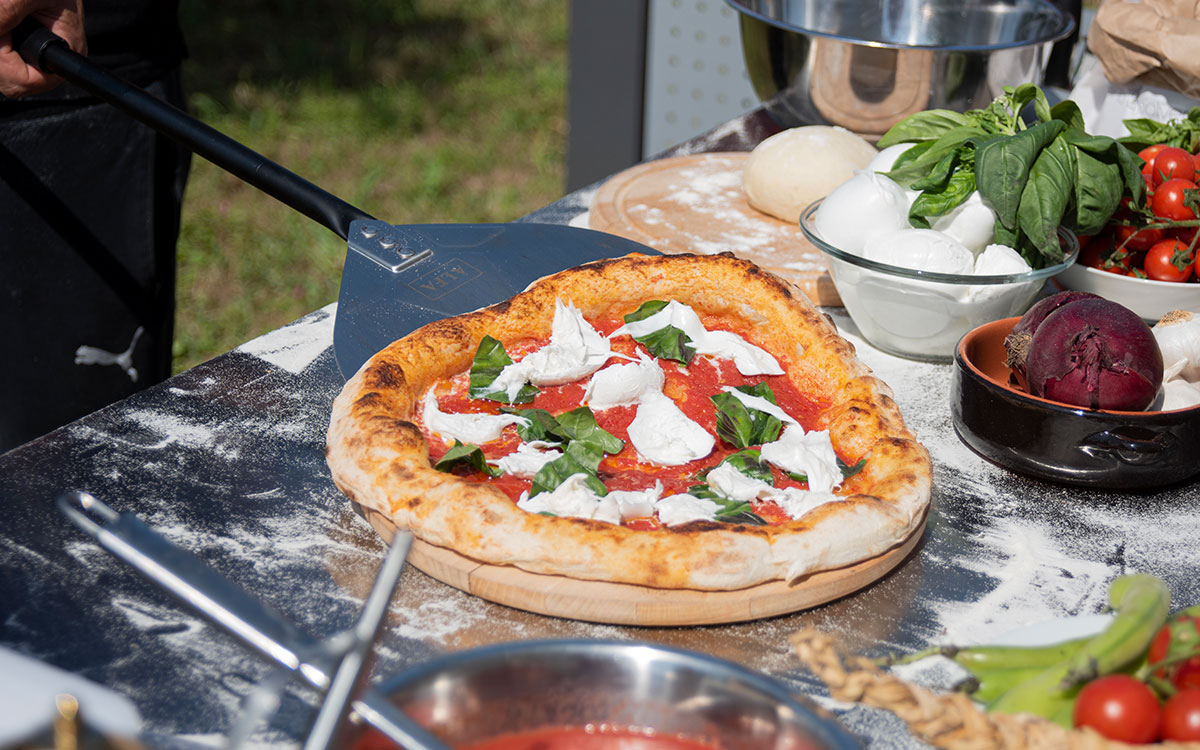The original Neapolitan pizza recipe has always been a debate among professional and amateur pizza makers, both with regard to the preparation of the dough and how it’s spread out, as well as to the choice of toppings and how to cook it in the oven.
People often think that pizza is a simple and quick dish to prepare, but pizza chefs know that it takes hours of hard work including researching best methods and preparing the dough. Ingredients and cooking appliance are also a factor.
There are so many variables involved in successfully making an exquisite pizza that in 2017 UNESCO recognized the art of the Neapolitan pizza chef as an intangible heritage of humanity. Not the pizza itself but the wealth of knowledge related to the preparation of this food.
In this article, we’ll try to clarify the main aspects to consider when making authentic Neapolitan pizza.
We’ll start by talking about the dough, providing some information on the choice of ingredients and the rising methods and times, to then illustrate the authentic Neapolitan pizza recipe.
Next, we’ll look at some important aspects to respected according to Neapolitan tradition, such as making the dough by hand, the “slapping” technique and preparing certain sauces and toppings.
Lastly, we’ll discuss how to perfectly cook pizza using a wood-fired pizza oven, ending with some tips for making Neapolitan pizza at home with an Alfa oven.
The Neapolitan pizza dough recipe
Let’s begin with a few words about the choice of raw ingredients, the foundation for the best results in any dish.
The Neapolitan pizza recipe includes type 0 or 00 soft wheat flour, water, salt and yeast. To respect the Neapolitan tradition, no other type of flour should be used, nor should you put any oil in the dough (or any other type of fat).
The different quantities of the ingredients for the pizza dough are usually calculated based on 4 cups of water, which corresponds to about 3.5 tablespoons of salt and about 8 cups of flour, to obtain a dough with about 60% hydration.
The hydration can also be a bit lower, which means adding a little more flour to the same amount of water, which allows the dough to rise faster while staying rather tough, a typical feature of Neapolitan pizza.
On the other hand, you can also slightly increase the hydration of the dough, thus decreasing the amount of flour in relation to the water, making sure, however, that stronger flours are used so that a good gluten base is formed. Using this method will require extended rise time to align them with those of growth so you can obtain an easily digestible pizza. All you need to do this is reduce the amount of yeast and let the dough rest in the fridge.
Finally, the amount of yeast you add to the dough varies depending on several factors. You must first consider the temperature and rising time you’ve planned on. This factor can vary depending on how you manage the rising (slow or fast) and the room temperature.
Another determining factor for proper rising is of course the type of yeast used and how it reacts in relation to the quality and amounts of the other ingredients in the dough.
To give you a reference to, it’s best to use between ½ to 1 teaspoon of fresh brewer’s yeast per ¼ cup flour. If you choose to use dry brewer’s yeast, you usually need to use between half and a third the amount of fresh yeast, while those who want to use starter culture can experiment with a very variable amount, between 5 and 20% of the weight of the flour, depending on the strength of the starter and all the other factors we have mentioned.
Now that we’ve taken a good look at the ingredients and the correct amounts in the Neapolitan pizza recipe, let’s take a look at a few important precautions for fully respecting the Neapolitan tradition, along with some advice on all the stages of preparing our favorite dish.

How to make authentic Neapolitan pizza
The main features of the traditional Neapolitan pizza recipe concern three fundamental aspects, which are:
- The method of making the dough
- The dough spreading technique
- The main ingredients in the pizza sauce
Let’s take a look at the Neapolitan pizza recipe for each of these preparation steps.
1 – The method of making the dough
Having just seen the ingredients and their amounts, let’s now talk about the method of making the Neapolitan pizza dough.
The Neapolitan pizza recipe involves making a direct dough, meaning a dough in which the ingredients are all added at the same time, without making pre-mixes such as biga or poolish.
The only technique that can be used to strengthen the gluten base of the dough is that of autolysis, although many Neapolitan pizza makers do without this too. Also called downtime in professional contexts, flour autolysis is a process that involves starting a dough with at least half of the water and flour (compared to the total provided by the recipe) and immediately letting it rest for about half an hour.
In this case it’s not important to have a pre-mix, all you need to do is make sure all the flour is wet to activate autolysis with a long initial pause, which will aid in the ability to form the dough, its elasticity and its toughness.
The Neapolitan pizza recipe involves making a quick dough, prepared in the afternoon and eaten in the evening, especially when made at home. In pizzerias, in addition to making large amounts, they also need to make a dough that can give excellent results even if two or three days pass between making the first and the last pizza.
For this reason, almost all pizzerias let their dough rest in the fridge, managing the rising simply by changing the temperature at which the dough rests.
This isn’t necessary when making authentic pizza at home, and in fact usually the dough is only put in the fridge for a few hours if it’s the middle of summer and it’s very hot, otherwise when making Neapolitan pizza at home, the dough always rests at room temperature.
Coming now to the actual dough process, as we mentioned, the Neapolitan pizza recipe calls for a fast dough. Precisely for this reason, an important feature of Neapolitan pizza is that salt and yeast can be added at the same time, but always separated.
In fact, the direct contact between the two weakens the strength of the yeast and usually making doughs for pizza involves adding salt at the end, both for the reason just mentioned and for salt’s property of drying out moisture. This factor allows a nearly finished dough to strengthen its gluten base that was formed at the end of the dough process, but this advantage is of little importance in making Neapolitan pizza, thanks to the preparation speed and rising of the dough.
To be faithful to the Neapolitan tradition, therefore, the homemade pizza dough must be prepared on a wooden board, starting from the flour, with the salt on one side and the yeast on the other, without letting them directly touch each other. Then gradually add the water on the area with the yeast and begin to mix only this part of the flour with your hands. Once the yeast has dissolved and you’ve kneaded a good half of the flour, you can finish adding the water and also begin mixing in the part of the flour with the salt, always little by little.
Once you’ve finished adding water, begin to knead very vigorously for at least ten minutes, using both hands to turn the dough over itself several times.
An effective method for developing a good gluten base when making dough by hand is to take the outer parts of the dough and lift them over the central part, with a sequence of circular folds that will help you obtain a single large ball of smooth, homogeneous dough.
One last tip to reinforce the dough is to make the classic three folds, which consist of spreading the dough in two opposite directions and folding it back on itself. This technique serves to increase the elasticity of the gluten and is carried out after a break of about ten minutes from the end of the mixing process, then taking another break of more or less the same amount of time before forming the dough balls.
To respect the Neapolitan tradition down to the smallest details, the latter should be around 1 ¼ cup of dough each and should rise in wooden containers.
2 – The dough spreading technique
Once our balls have risen well and the oven has been properly pre-heated, it’s time to roll out our pizzas like true pizza chefs.
Real pizza is initially spread by gently crushing the dough to move the air from the center towards the edges, to form the Neapolitan pizza crust. This must be done on both sides of the pizza, lightly flouring both the worktop and the dough.
At this point you should have obtained a small, thick disc of dough, which must become a thin pizza in the centre but with a pronounced Neapolitan pizza crust with the few typical movements of the Neapolitan spreading technique involving slapping.
This spreading technique involves lifting one edge of the pizza with one hand to put it on the other, which with a quick rotation of the wrist turns it and enlarges it at the same time. By quickly repeating this movement you can enlarge the pizza in little time, using only three or four slaps to complete the rotation of the pizza and finish spreading.
It takes a bit of practice to acquire the right manual skills. Moreover, the dough slapping technique requires a certain speed to be effective, because if done too gently, you won’t manage to properly spread a well-made dough.
3 – The main ingredients in the pizza sauce
Now that the base of your pizza is ready, you can proceed with the pizza sauce.
When it comes to Neapolitan pizza, the main ingredients to be mentioned are obviously tomato and mozzarella, since together with extra virgin olive oil and basil they are the soul of the noblest version of this dish, the one dedicated to Queen Margaret.
Let’s start with a brief discussion about the tomatoes, the base of so many pizza sauces.
To fully respect the Neapolitan pizza recipe, the tomato sauce must be made using San Marzano PDO tomatoes puréed without the use of electrical tools, to maximize the quality of the product. The sauce must be seasoned exclusively with salt, without adding oil, oregano or other spices.
The other undisputed protagonist of pizza is the mozzarella, which according to Neapolitan tradition can be of cow’s milk or buffalo milk. The mozzarella must be cut by hand into not overly thin strips, which you need to let drain for at least a few hours before using.
The last tricks for fully respecting the Neapolitan tradition regarding the main toppings are the use of tomato sauce and mozzarella at room temperature and the addition of a drizzle of extra virgin olive oil on the pizza only after cooking.

How to cook Neapolitan pizza in a wood-fired pizza oven
Once your pizza has all its toppings, it’s time to grab your pizza peel and cook. Also here, you’ll need to take certain precautions as to respect the Neapolitan tradition:
- The peel, historically, was made of wood, but technological innovations and the introduction of new materials have led to the development of much lighter aluminium peels designed to optimize the different phases: perforated to remove excess flour, equipped with a slide to improve grip, and much more resistant.
- To put the pizza on the peel, simply place the peel on your worktop and move the pizza directly on top of it. Make sure you do this without crushing the Neapolitan pizza crust and rotating the pizza while moving it, so as to ultimately enlarge the pizza to its final size directly on the peel.
- Slide the pizza off the peel in one quick blow, directly into the oven; this step will also determine the final shape of your pizza. One trick to help you obtain round pizzas is to give it a slightly oval shape when you place it on the peel, which compensates for the elongation that could occur if you don’t place it perfectly in the oven.
Now that we’ve told you about the Neapolitan way to place pizza in the oven, let’s briefly talk about cooking in a wood-fired pizza oven.
The ovens were traditionally made of bricks, but their extreme weight, difficult handling logistics, new technologies and the greater performance obtained have allowed to introduce new models with a refractory core and steel coating, our FORNINOX.
A traditional wood-fired pizza oven needs to be lit at least two or three hours before use, in order to cook the pizzas at around 800° F, an optimal temperature to be able to complete cooking in about 90 seconds, as per Neapolitan tradition. This makes it necessary to consume much more wood (which costs more) and also to have to physically stand in front of the oven to control the fire for much longer.
The high weight of the structure in refractory bricks and concrete also forces a fixed installation of the traditional wood-fired pizza oven, due to the need for a very solid base that will permanently occupy part of your outdoor area.
To respect the Neapolitan tradition, it is also necessary to carefully choose the best firewood, preferring oak and beech which have been dried well and certified for food use.
When cooking pizzas in a traditional wood-fired pizza oven, you must also consider the temperature differences between the different areas of the oven. These differences are mainly due to the distance between the pizza and the fire (which cooks by irradiation and promotes the perfect cooking of the Neapolitan pizza crust), and the position of the pizza between the bottom and the mouth of the oven (since the temperature of the base changes and therefore the cooking by conduction of the lower part).
The last precaution to remember is therefore to try to align the cooking of the upper part with the lower one, switching the position of the pizzas and rotating them 180° halfway through cooking, in order to obtain a perfect result.
Once the last pizza has been cooked, you can easily put the lid on to extinguish the remaining fire and let the oven cool down slowly.
Managing a large outdoor pizza oven requires a lot of experience, but you can choose a small and innovative oven to cook Neapolitan pizza at home, even in smaller spaces such as a terrace.

Making real Neapolitan pizza at home with an Alfa wood-fired pizza oven
After having described the process for obtaining the perfect pizza cooked in a wood-fired pizza oven according to Neapolitan tradition, we’d like to end this guide to the Neapolitan pizza recipe by mentioning the possibilities offered by the range of Alfa residential wood-fired ovens to prepare this extraordinary dish.
In addition to having to watch the fire for a long time, the disadvantage of traditional ovens lies in the fact of having to consume a large amount of wood.
However, these two negative aspects can be overcome thanks to the technology of the steel wood-fired pizza ovens by Alfa. These cooking tools were created to meet the needs of amateur pizza makers who want to experiment with cooking with wood at high temperatures, but with the advantage of being much faster to warm up, managing to reach very high temperatures in tens of minutes.
The great thermal efficiency makes our domestic steel ovens capable of cooking pizzas worthy of a professional pizzeria. In addition to the extraordinary heating performance, our steel ovens can also ensure a second very important advantage, namely ease of movement.
In fact, steel is much lighter than the brick and refractory stone with which traditional pizza ovens are made, and this feature has allowed us to develop solid structures with wheels on which to install residential outdoor ovens, made to measure for most of our models.
Ovens without a custom base can still take advantage of mobility by being installed on our multi-functional base for pizzas. This accessory includes a steel table equipped with professional wheels, on which you can place an Alfa steel oven, which also gives you space to spread the pizzas in addition to including useful accessories such as a pizza peel holder.
In conclusion, we can summarize by saying that respecting the authentic Neapolitan pizza recipe is also possible at home, following the advice we have provided regarding the preparation of the dough and ingredients and choosing a pizza oven capable of guaranteeing high temperatures.
Alfa steel wood-fired or gas ovens overcome the structural constraints of traditional wood-fired ovens and can boast unparalleled thermal efficiency, saving a great deal of wood and time.
They are therefore the ideal choice for pizza lovers who don’t want to permanently occupy their outdoor spaces, especially for those who have a terrace or a smaller garden, thanks to the great advantage of being able to move them around.




